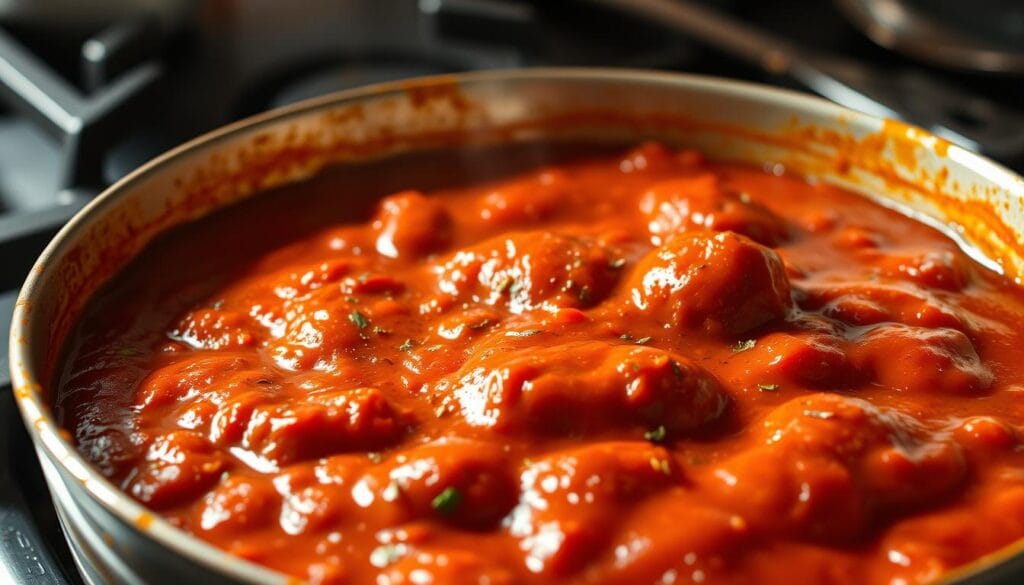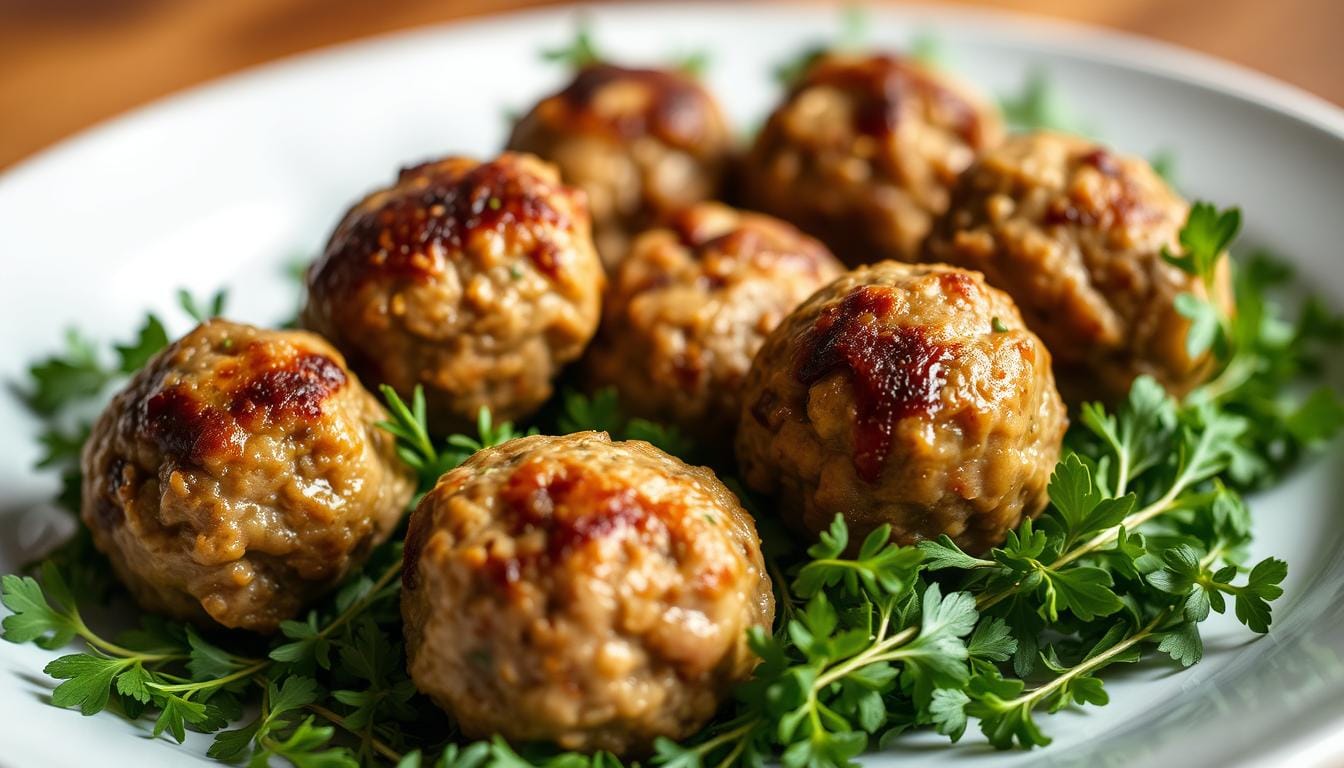When making gluten-free meatballs, you want them to taste great and be safe for those with gluten issues. There’s a growing need for gluten-free dishes. To make the best meatballs, mix ground beef and pork with a gluten-free bread panade, eggs, and milk. This mix makes your meatballs moist and tasty, and it’s easy to do.
Introduction to Gluten-Free Meatballs
To make perfect gluten-free meatballs, pay close attention to your ingredients and method. Use 1 pound each of ground beef and pork for flavor. Mix in 2 large eggs, ¼ cup of milk, and 2 cups of gluten-free bread for moisture. Broil for 5-7 minutes and then simmer in sauce for 10-15 minutes. This way, you get the best gluten-free meatballs easily.
Key Takeaways
- Use a mix of ground beef and pork for better flavor in your gluten-free meatballs.
- A gluten-free bread panade with eggs and milk adds moisture and tenderness, making it the best recipe.
- Cooking methods like broiling and simmering help get the right texture. With an easy recipe, you can make them at home.
- Gluten-free meatballs can be stored in an airtight container in the fridge for up to 5 days. Uncooked ones can be refrigerated for 1-2 days or frozen for up to 3 months.
- Always check the meatballs’ internal temperature to ensure it’s 165°F for safety. Use a reliable recipe like the best gluten-free meatball recipe for perfect results.
- Try different seasonings and sauces to find your favorite flavor. Making an easy gluten-free meatball recipe is a quick and tasty option.
- Use gluten-free corn flake crumbs from brands like Nature’s Path or Arrowhead Mills for extra texture. Choose the best gluten-free meatball recipe for your needs.
Understanding Gluten-Free Meatballs
Making homemade gluten free meatballs means knowing why regular meatballs have gluten. Traditional meatballs often include gluten from breadcrumbs or other gluten-rich ingredients. But, with gluten-free options available, we can now enjoy tasty and healthy gluten free meatballs.
To make gluten-free meatballs, we use ingredients without gluten. This includes gluten-free oats or Italian bread crumbs. It makes the meatballs safe for those with gluten issues. Plus, it boosts their nutritional value, making them a healthy gluten free choice.
The gluten free meatball sauce is also key. A great sauce can make the meatballs even more delicious. When making gluten-free meatballs, it’s important to pick a gluten-free sauce. This keeps the dish gluten-free and flavorful.
Essential Ingredients for the Perfect Gluten-Free Meatballs
Choosing the right ingredients is key when making gluten-free meatballs. For turkey meatballs, use ground turkey, gluten-free breadcrumbs, and a mix of egg, garlic salt, and spices. For vegan meatballs, try tofu, tempeh, or seitan with gluten-free oats and spices.
Decide on the ground meat for your meatballs. You can use beef, pork, or a mix for traditional meatballs. Gluten-free turkey or vegan meatballs are great alternatives. A gluten-free binder like breadcrumbs or almond meal helps them stick together.
- Ground meat (beef, pork, turkey, or vegan alternatives)
- Gluten-free breadcrumbs or almond meal
- Egg
- Garlic salt
- Spices (such as nutmeg, allspice, and parsley)
With the right ingredients and a simple recipe, you can make tasty gluten-free meatballs. Whether you’re making turkey or vegan meatballs, focus on quality ingredients. And remember, don’t overmix the meat mixture.
Best Gluten-Free Binding Alternatives
When making gluten-free Italian meatballs, finding the right binding agents is key. Traditional breadcrumbs often have gluten, so we need alternatives. Almond flour is a great option to add structure to the meatballs. Rice-based binders like rice flour or rice crumbs also work well to hold the meatballs together.
For a gluten-free meatball substitute, mix gluten-free flours like almond flour, coconut flour, or rice flour. These can replace traditional breadcrumbs. For instance, quick oats can be used as a binding agent in gluten-free meatballs, offering a similar function to bread crumbs.
- They are gluten-free, making them suitable for people with gluten intolerance or celiac disease
- They can be used to make a variety of different types of meatballs, including gluten free italian meatballs
- They can help to add structure and texture to the meatballs, making them more cohesive and easier to cook
To add flavor to your gluten-free Italian meatballs, try different seasonings and ingredients. Use Italian-style seasonings like basil, oregano, and thyme. This will give your meatballs a traditional Italian taste.
Preparing Your Meat Mixture
To make an easy gluten free meatball recipe, start with the right ingredients. You’ll need ground beef as the main ingredient. Mix it with gluten-free Italian bread crumbs, egg, milk, and spices for a tasty homemade gluten free meatballs recipe.
When mixing your meat, use the right amounts of meats, spices, and binders. A good mix is ½ pound ground beef and ½ pound ground pork. Quick oats can replace traditional bread crumbs as a binder. Remember, don’t overmix to avoid dense meatballs.
Here are some tips for your meat mixture:
- Use 90% lean ground beef for less fat leakage during baking.
- Add a mix of egg, milk, and spices for extra flavor.
- Choose certified gluten-free oats to avoid cross-contamination.
By following these tips and using the right ingredients, you can make delicious gluten free meatballs. They’re perfect for any occasion, whether as an appetizer or main course. Homemade gluten free meatballs are always a hit.
Seasoning Secrets for Flavorful Results
Seasoning is key when making gluten free meatballs. The right mix of spices and herbs can make your meatballs taste amazing. To get the best flavor, it’s important to know how to season them right.
Start by trying different seasoning blends. Italian-Style Seasonings are a good choice, with herbs like basil and oregano. Or, go for Mediterranean with cumin and coriander. For something different, try Asian-Inspired with soy sauce and ginger.
Italian-Style Seasonings
Italian-Style Seasonings are a classic choice. They include herbs like basil and thyme for a fresh taste. Adding garlic and lemon zest can make them even better.
Mediterranean Flavor Profiles
Mediterranean Seasonings add a unique flavor to your meatballs. They use spices like cumin and paprika for a warm taste. Adding olives and artichokes can make it even more exciting.
Asian-Inspired Variations
Asian-Inspired Seasonings bring a savory flavor to your meatballs. Soy sauce and ginger are key ingredients. Adding green onions and bell peppers can enhance the taste.
Experimenting with different seasonings can help you find the perfect gluten free meatball recipe. Use high-quality spices and don’t be afraid to try new things.
| Seasoning Blend | Ingredients | Flavor Profile |
|---|---|---|
| Italian-Style | Basil, oregano, thyme, garlic, onion, lemon zest | Bright, fresh, herbaceous |
| Mediterranean | Cumin, coriander, paprika, olives, artichokes, sun-dried tomatoes | Warm, earthy, savory |
| Asian-Inspired | Soy sauce, ginger, sesame oil, green onions, bell peppers, snow peas | Savory, umami, slightly sweet |
Step-by-Step Rolling Technique
To make perfect gluten-free meatballs, you need to get the rolling right. First, wet your hands a bit with water. This keeps the meat from sticking to your hands. Then, take a small part of the mix and shape it into a ball. Use gentle pressure to make it keep its shape.
It’s important to make the meatballs the same size and shape. This helps them cook evenly and have the same texture. Using a gluten-free meatball substitute can help the mix stick together better. This makes shaping and rolling easier.
After rolling all the meatballs, put them on a baking sheet lined with parchment paper. Make sure there’s space between each one for even cooking. Then, bake them in the oven with your favorite gluten free meatball sauce. This makes for a tasty and fulfilling meal.
By following these easy steps and using the right ingredients, you can make amazing gluten-free meatballs. They’ll impress anyone, whether you use a gluten-free meatball substitute or a traditional recipe. The secret is in the rolling technique and the quality of your ingredients.
Cooking Methods for Perfect Texture
Cooking gluten free turkey or vegan meatballs can be tricky. But, the right cooking method can make them perfect.
You can cook them by pan-frying, baking, or air frying. Each method has its own good points and bad points. Your choice depends on what you like and the type of meatballs.
For instance, pan-frying makes gluten free turkey meatballs crispy on the outside and juicy inside. Baking is better for gluten free vegan meatballs. It keeps them moist and flavorful.
The temperature and cooking time are also key. Cooking gluten free turkey meatballs at 375 degrees Fahrenheit for 18-20 minutes is ideal.
The ingredients you use also matter. Gluten-free breadcrumbs help the ingredients stick together, making the meatballs more cohesive.
Other tips include not overmixing the ingredients and using the right amount of liquid. Also, don’t overcook the meatballs. By following these tips and choosing the right method, you can make delicious, perfectly textured meatballs.
Creating Delicious Gluten-Free Meatball Sauce
When serving gluten free italian meatballs, a tasty sauce is key. You can mix canned tomatoes, olive oil, garlic, and herbs to make a great sauce. Adding a gluten-free meatball substitute boosts the flavor.
Canned tomatoes are a must in gluten-free meatball sauce. Choose crushed or diced tomatoes for the right texture. Add olive oil, garlic, and herbs like basil or oregano for flavor. Gluten-free breadcrumbs or almond flour can add texture.
| Ingredient | Quantity |
|---|---|
| Canned Tomatoes | 2 cups |
| Olive Oil | 1/4 cup |
| Garlic | 3 cloves |
| Herbs | 1 tablespoon |
| Gluten-Free Breadcrumbs | 1/2 cup |
This sauce is great with gluten free italian meatballs. It’s also good for dipping gluten-free bread or veggies.
Healthy Turkey and Chicken Variations
Using lean meats like turkey and chicken is a smart choice for gluten free meatballs. They offer a tasty and healthier option compared to beef or pork. Mix ground turkey or chicken with gluten-free breadcrumbs, eggs, and spices for a tender and flavorful dish.
Choosing the right meat is key for the best gluten free meatballs. Opt for lean ground turkey or chicken with low fat. Adding fat-free ricotta cheese or a dairy-free alternative helps keep the meatballs moist and juicy.

- Use gluten-free breadcrumbs to avoid any gluten contamination
- Add some garlic powder and onion powder to give the meatballs a boost of flavor
- Use olive oil for drizzling instead of other oils to reduce the calorie count
- Choose a low-sodium cheese option to reduce the salt content
By following these tips, you can make delicious and healthy gluten free meatballs. They’re great for any meal, from a quick snack to a main course. Get creative and experiment to find your own unique gluten free meatball recipe.
Plant-Based and Vegan Options
Gluten-free vegan meatballs offer many choices. You can use ingredients like mushrooms, walnuts, and oats. These give a meatball-like texture and can be seasoned for a tasty flavor.
Gluten-free vegan meatballs are healthier than regular ones. They have fewer calories and fat. For instance, one meatball has just 44 calories, 2 grams of fat, and no cholesterol. They also have fiber and protein, making them a good choice for meals or snacks.
Ingredients like gluten-free oats, mushrooms, and walnuts are popular for meatballs. You can mix them with black beans, onions, and garlic for extra flavor. Just mix everything in a bowl, shape into balls, and cook until golden and done.
- Use a variety of ingredients to add texture and flavor
- Don’t overmix the ingredients, as this can make the meatballs dense and heavy
- Use a gluten-free binding agent such as flaxseed or chia seeds to help hold the meatballs together
- Experiment with different seasonings and spices to find the flavor you like best
By following these tips and using a gluten-free meatball substitute, you can make tasty and healthy gluten-free vegan meatballs. They’re great for pasta, marinara sauce, subs, and sandwiches.
Storing and Freezing Your Meatballs
After making your gluten free meatballs, it’s key to store and freeze them right. This keeps their taste and quality. You can keep them in the fridge for 3-4 days in a sealed container.
To freeze them, you can store raw or cooked meatballs for up to 3 months. Raw meatballs should be flash-frozen on a baking sheet first. Then, move them to a freezer-safe bag or container. This stops them from sticking together.
To reheat frozen gluten free meatballs, use the stovetop or oven. Just put them in a sauce or broth and warm them up. You can also microwave them, but watch out not to overheat them.
Here are some tips for storing and reheating your gluten free meatballs:
- Store them in an airtight container in the refrigerator for up to 3-4 days.
- Freeze them for up to 3 months.
- Reheat them on the stovetop or in the oven.
- Avoid overcooking them, as this can make them dry and tough.
By following these tips, you can enjoy your gluten free meatballs for a longer time. They’ll stay flavorful and tender. Whether you’re using a simple or complex recipe, right storage and reheating are key for the best taste.
Troubleshooting Common Issues
When making gluten-free meatballs, you might face some problems. One issue is that they might not stay in shape. To fix this, add more gluten-free binding agents like eggs or breadcrumbs to the mix. If the meatballs feel too dense or dry, add a bit more moisture. Use milk or olive oil and mix gently to avoid overmixing.
Using a gluten-free meatball sauce can also help. You can make your own using canned tomatoes, olive oil, and herbs. Or, you can buy one from the store. For a meat-free option, try using tofu, tempeh, or seitan. These can be marinated and cooked like regular meatballs.
Here are some tips for fixing common problems with gluten-free meatballs:
- Handle the meat mixture gently to avoid making it dense.
- Use a mix of gluten-free binding agents, like eggs and breadcrumbs, to help them stay in shape.
- Don’t overcook the meatballs. They should be just done. Let them rest for a few minutes before serving.

By following these tips and using gluten-free meatball sauce and substitutes, you can make delicious meatballs. They’re perfect for any time.
Serving Suggestions and Pairings
There are many ways to serve gluten free italian meatballs. You can make them the main dish or pair them with other foods for a complete meal. In the U.S., it’s common to serve them with pasta. But, you can also enjoy them with roasted vegetables or a fresh salad.
For a lighter meal, try them with lemon gnocchi or a pasta salad. Or, for something richer, serve them with lobster ravioli or creamy mashed potatoes. The goal is to mix flavors and textures for a meal that’s both tasty and filling.
Some great side dishes for meatballs include:
- Biscuits, perfect for soaking up meatball sauce
- A sweet and spicy salad, featuring teriyaki meatballs
- Roasted potatoes, elevated with squash to complement turkey meatballs
The right side dish depends on your taste and the meatballs you’re using. With over 30 options, you’ll find the perfect match for your gluten free italian meatballs.
Conclusion
Creating tasty gluten-free meatballs is easier than you think. Even if you’re new to cooking, you can make delicious meatballs. Just know the right ingredients, techniques, and cooking methods.
Want to try Italian, Mediterranean, or Asian-style meatballs? This guide has you covered. You can make your gluten-free meatballs your own. Try different ingredients and cooking ways to get the perfect texture.
Great gluten-free meatballs start with quality ingredients and careful prep. Follow the steps and tips in this guide. You’ll make the best gluten-free meatball recipe that everyone will love.
Now, it’s time to get creative in the kitchen. Enjoy the flavors of gluten-free meatballs. You’ll feel proud to serve a dish that’s good for everyone and tastes amazing.
FAQ
What makes traditional meatballs not gluten-free?
What are the benefits of gluten-free alternatives for meatballs?
What are some common misconceptions about gluten-free cooking?
What are the essential ingredients for perfect gluten-free meatballs?
What are the best gluten-free binding alternatives for meatballs?
What are the key steps in preparing the meat mixture for gluten-free meatballs?
What are the seasoning secrets for flavorful gluten-free meatballs?
What is the step-by-step technique for rolling perfect gluten-free meatballs?
What are the different cooking methods for gluten-free meatballs?
How do you create a delicious gluten-free meatball sauce?
What are the benefits of using lean meats for healthier turkey and chicken meatballs?
What are the options for plant-based and vegan gluten-free meatballs?
How do you properly store and freeze gluten-free meatballs?
What are some common issues that can arise when making gluten-free meatballs?
What are some serving suggestions and pairings for gluten-free meatballs?
Table of Contents
Did you like this recipe?
There are no reviews yet. Be the first one to write one.

